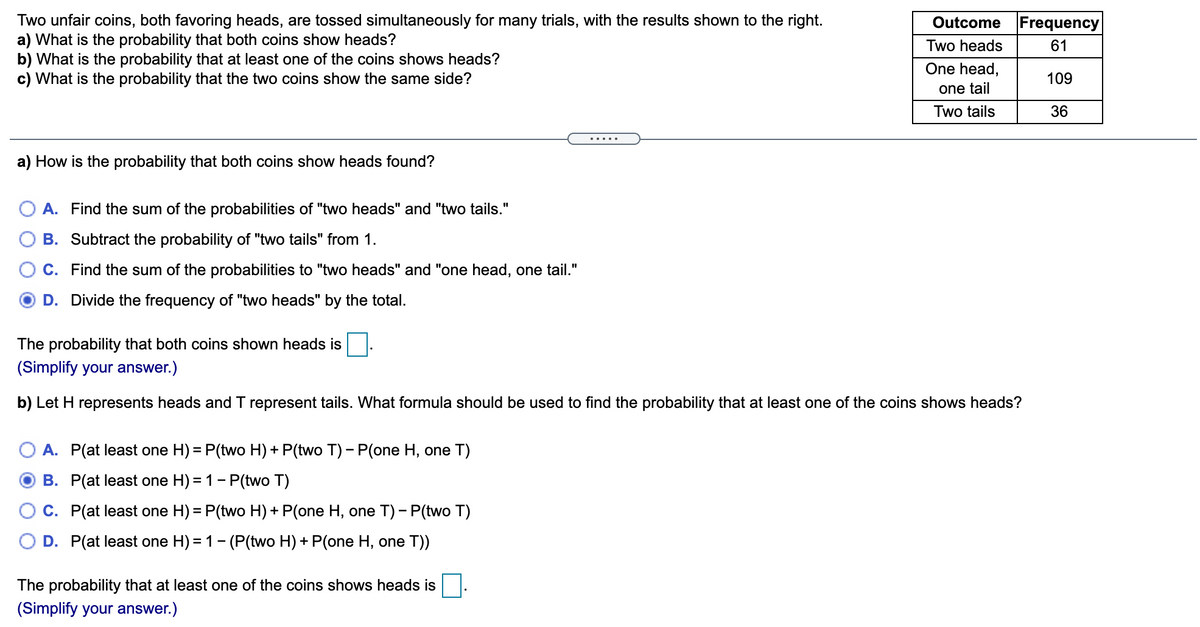Outcome Frequency Two unfair coins, both favoring heads, are tossed simultaneously for many trials, with the results shown to the right. a) What is the probability that both coins show heads? b) What is the probability that at least one of the coins shows heads? c) What is the probability that the two coins show the same side? Two heads 61 One head, 109 one tail Two tails 36 a) How is the probability that both coins show heads found? A. Find the sum of the probabilities of "two heads" and "two tails." O B. Subtract the probability of "two tails" from 1. O C. Find the sum of the probabilities to "two heads" and "one head, one tail." O D. Divide the frequency of "two heads" by the total. The probability that both coins shown heads is (Simplify your answer.) b) Let H represents heads and T represent tails. What formula should be used to find the probability that at least one of the coins shows heads? O A. P(at least one H) = P(two H) + P(two T) - P(one H, one T) O B. P(at least one H) = 1- P(two T) O C. P(at least one H) = P(two H) + P(one H, one T) - P(two T) O D. P(at least one H) = 1- (P(two H) + P(one H, one T)) The probability that at least one of the coins shows heads is. (Simplify your answer.)
Outcome Frequency Two unfair coins, both favoring heads, are tossed simultaneously for many trials, with the results shown to the right. a) What is the probability that both coins show heads? b) What is the probability that at least one of the coins shows heads? c) What is the probability that the two coins show the same side? Two heads 61 One head, 109 one tail Two tails 36 a) How is the probability that both coins show heads found? A. Find the sum of the probabilities of "two heads" and "two tails." O B. Subtract the probability of "two tails" from 1. O C. Find the sum of the probabilities to "two heads" and "one head, one tail." O D. Divide the frequency of "two heads" by the total. The probability that both coins shown heads is (Simplify your answer.) b) Let H represents heads and T represent tails. What formula should be used to find the probability that at least one of the coins shows heads? O A. P(at least one H) = P(two H) + P(two T) - P(one H, one T) O B. P(at least one H) = 1- P(two T) O C. P(at least one H) = P(two H) + P(one H, one T) - P(two T) O D. P(at least one H) = 1- (P(two H) + P(one H, one T)) The probability that at least one of the coins shows heads is. (Simplify your answer.)
Chapter8: Sequences, Series,and Probability
Section8.7: Probability
Problem 50E: Flexible Work Hours In a recent survey, people were asked whether they would prefer to work flexible...
Related questions
Question

Transcribed Image Text:Outcome Frequency
Two unfair coins, both favoring heads, are tossed simultaneously for many trials, with the results shown to the right.
a) What is the probability that both coins show heads?
b) What is the probability that at least one of the coins shows heads?
c) What is the probability that the two coins show the same side?
Two heads
61
One head,
109
one tail
Two tails
36
.....
a) How is the probability that both coins show heads found?
A. Find the sum of the probabilities of "two heads" and "two tails."
B. Subtract the probability of "two tails" from 1.
O C. Find the sum of the probabilities to "two heads" and "one head, one tail."
D. Divide the frequency of "two heads" by the total.
The probability that both coins shown heads is
(Simplify your answer.)
b) Let H represents heads and T represent tails. What formula should be used to find the probability that at least one of the coins shows heads?
A. P(at least one H) = P(two H) + P(two T) – P(one H, one T)
B. P(at least one H) = 1- P(two T)
O C. P(at least one H) = P(two H) + P(one H, one T) – P(two T)
D. P(at least one H) = 1- (P(two H) + P(one H, one T))
The probability that at least one of the coins shows heads is
(Simplify your answer.)

Transcribed Image Text:c) What formula should be used to find the probability that the two coins show the same side?
A. P(same side) = P(two H) + P(two T)
B. P(same side) = P(two H) + P(two T) - P(one H, one T)
C. P(same side) = P(two H) • P(two T)
D. P(same side) = 1- (P(two H) + P(two T))
The probability that the two coins show the same side is
(Simplify your answer.)
Expert Solution
This question has been solved!
Explore an expertly crafted, step-by-step solution for a thorough understanding of key concepts.
Step by step
Solved in 2 steps with 2 images

Recommended textbooks for you


College Algebra
Algebra
ISBN:
9781305115545
Author:
James Stewart, Lothar Redlin, Saleem Watson
Publisher:
Cengage Learning


College Algebra
Algebra
ISBN:
9781305115545
Author:
James Stewart, Lothar Redlin, Saleem Watson
Publisher:
Cengage Learning